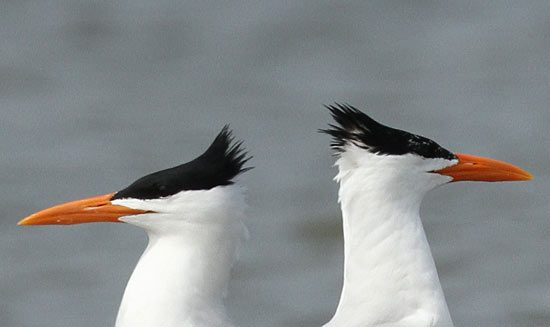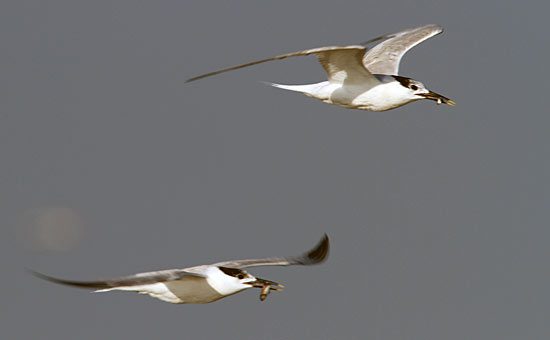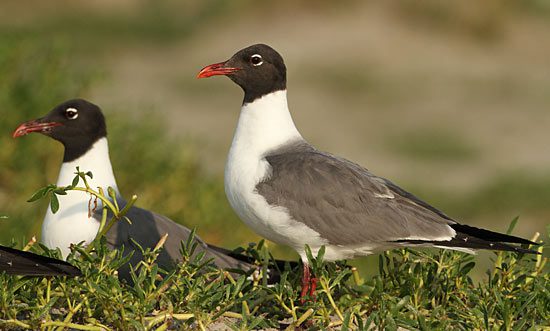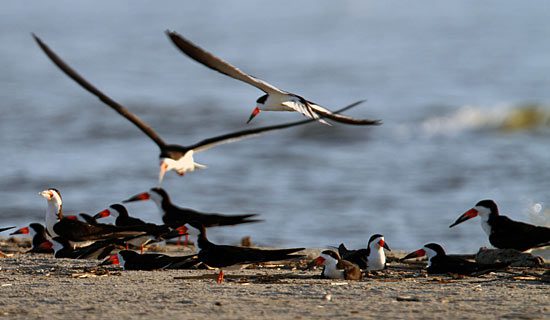Louisiana report: A hundred thousand seabirds (slideshow)
Text by Hugh Powell. Images by Benjamin Clock.
June 28, 2010

Breton Island is home to thousands of breeding Royal Terns 

Louisiana has nearly 3/4 of the nation's Sandwich Terns, many of them on Breton 

Thousands of Laughing Gull wings blur the air over the colony 

We visited Breton Island with the assistance of the US Fish and Wildlife Service 

Sandwich Terns (black bills) and Royal Terns (orange bills) nest right on top of each other 

The extent of the colony is breathtaking—this is one small section 

Pale dots in the background look like a field of flowers, but they're pelican heads 

A very few birds at Breton are oiled, like this young pelican. Sadly, it's too disruptive to the rest of the colony to rescue them 

Sandwich Terns stand about a head shorter than Royals. Can you find two here? 

A Royal Tern alights on a sandbar with a fish for a mate or a chick 

Laughing Gull nests cover the low-vegetated parts of Breton, spaced about two feet apart 

Boom rings the island, and shrimpers patrol the nearby waters for oil 

A group of terns and gulls bathes on a sandbar in the early morning 

A small group of Black Skimmers nested right at the water's edge 

Gulf waves push flotsam to within inches of the skimmer nests 

By 6 a.m., terns were already returning from fishing trips out into the Gulf 

Some young shorebirds, like these Sanderlings, opt to spend a summer in coastal Louisiana 

A group of Willets in nonbreeding plumage strolls the sandbar at Breton
On Friday we visited the magnificent seabird colonies of Breton Island, home to some 100,000 terns, pelicans, and gulls. After witnessing some heavily oiled mangrove islands the day before (more on this in a later post), it was a relief to see such a vibrant spectacle with little sign of oil.
Breton National Wildlife Refuge is a collection of barrier islands off of eastern Louisiana (map). It contains the pristine Chandeleur Islands, one of the first places oil from the Deepwater Horizon disaster came ashore. Breton Island itself is one of the largest seabird colonies in the nation. Coastal Louisiana is home to about three-quarters of the nation’s Sandwich Terns, and most of them breed here on Breton, alongside around 15,000 Royal Tern pairs, 6,000 pelican pairs, and thousands more Laughing Gulls.
Amid the constant coming-and-going of terns, the gull cries and the tern shrieks, and the smell of thousands upon thousands of fishy meals, all I could think of was John Steinbeck’s description of Cannery Row: “a poem, a stink, a grating noise, a quality of light….”
The U.S. Fish and Wildlife Service has made special efforts to protect Breton from oil. In addition to the orange containment boom and white absorbent boom we’ve seen everywhere, taller black Navy boom had been installed. Workers patrol the rings of boom each day to check they stay in place and to fix any gaps. Shrimp boats that had been turned into oil skimmers were on guard nearby, perhaps in anticipation of weather from Tropical Storm Alex.
Amid so much uncertainty about where oil will hit and what it will do to the Gulf Coast ecosystem, it was a comfort to stand at the edge of Breton’s chaos. In the early morning light the heavy pelicans carved dark circles above the island, and a confetti of silvery terns drifted over them. If even a few places like Breton can be preserved, then hope still exists that seabirds will survive this.
That, of course, is the definition of a refuge, and it’s exactly what Theodore Roosevelt had in mind when he created the National Wildlife Refuge system. In a satisfying show of foresight, Breton was the nation’s second one to be designated.
Thanks to senior biologist James Harris and assistant refuge manager Drew Wirwa for allowing us to visit and for accompanying us.


All About Birds is a free resource
Available for everyone,
funded by donors like you




